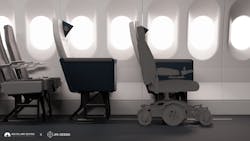New Airline Seat Design Will Allow Disabled Passengers to Fly in Their Own Wheelchairs
Molon Labe Seating of Denver, Colorado has unveiled a prototype of a new airline seat that will allow Passengers of Restricted Mobility (PRM’s) to fly on airlines in their own wheelchairs.
The Problem
Currently passengers in wheelchairs can’t fly in them. They must transfer from their wheelchair into a Skychair to get down the narrow aisle and then transfer again into their airline seat.
Disabled access for air travel is immensely challenging at best and dehumanizing at worst, which is why many people with disabilities avoid air travel completely. The problems encountered include: o wheelchairs getting damaged when transported in cargo bays of aircraft, o PRM injuries caused during transfers, o loss of independence as PRM’s must leave their own chair o little-to-no access to the bathroom in-flight o inability to perform regular body extensions/therapy in-flight which many powered wheelchairs can do
The Solution
Our design is based on the proven Side-Slip Seat design but it is modified from a standard economy-class triple seat to a very wide economy-class double seat.
During normal operations it is a normal economy-class seat, but when required, the aisle seat is slid over the top of the window seat and locked into place for normal use. The space opened by sliding the aisle seat over the top of the window seat offers 36” wide space to secure a manual or powered wheelchair in place. A Q-Straint wheelchair docking system; already widely used on buses and trains, is used to secure the wheelchair to the aircraft cabin floor.
One advantage of this design is that airlines do not lose any revenue or real estate, which has been an issue with previous designs attempting to address this problem. Another advantage is that PRM’s are flying in their own wheelchairs which often house many accessibility features specific to their needs.
There is significant regulatory and legislative pressure and momentum to allow wheelchairs to fly on planes. In September 2019, the US Department of Transportation announced the formation of the Air Carrier Access Act Advisory Committee (ACAA Advisory Committee), established pursuant to the FAA Reauthorization Act of 2018. The goal of this committee is to essentially improve the air travel experience of passengers with disabilities and increase its access to air travel. The FAA Reauthorization Act also included the mandate to perform a study on the feasibility of in-cabin wheelchair restraint systems and the subsequent accommodations needed.
Molon Labe, LLC Hank Scott contact@airlineseats.biz
Molon Labe has launched a GoFundMe campaign to expedite the design, engineering, analysis and certification of this seat.
‘It costs millions to design and certify an airline seat. We are a small start-up with limited resources and our recently certified S1 economy-class seat is our main focus right now. So we chose to crowdfund this project so we can get it certified and in the air as soon as possible, we want to be flying within 18 months but we need the public’s help’ Hank Scott, CEO, Molon Labe Seating.
The GoFundMe campaign is here: Hastag: #flyingwheelchairs GoFundMe Campaign link: gofundme.com/f/flyingwheelchairs




